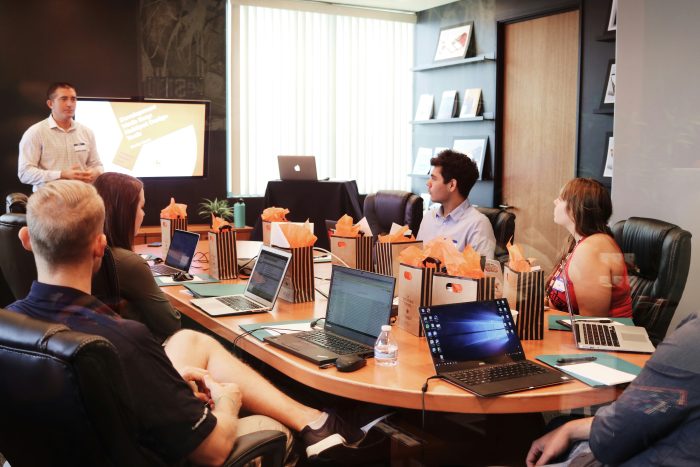By Carolyn Hobdey
I’ve spoken to three small business owners recently who have chosen to go back to working alone.
Operating in completely different sectors, all cited the challenges of leading people as the reason.
“Managing people just became too hard”, said one of them. It was a sentiment shared by the others. Increased expectations, growing demands, and not wanting to work hard were details they gave behind why leading people felt like it was becoming more onerous than in the past.
When I say ‘in the past’, I mean pre-pandemic.
A lot has changed in the last 4 years. We know this. What we all thought would be going back to normal, has been far from that. It appears that the fall-out is only now starting to truly show itself. The long-anticipated post-pandemic hangover is here.

“I couldn’t seem to please them”, one former owner told me, “Every time I dealt with one issue, another one would crop up with someone else!”
It seems that leading teams has become a perpetual game of whack-a-mole for those who started a business because they were passionate about what they did. As success grew from their talent, so did their teams and so did their problems.“ I was spending so much time dealing with my employees that I wasn’t spending the time I wanted with my customers doing what I loved. I simply couldn’t do it anymore.”
This was echoed in all the conversations I had. The exasperation was palpable as was the bewilderment about what to do about it. In each case the former owners felt like they had failed. “I felt responsible for these people’s livelihoods, their mortgages, and their families, but they no longer seemed to want to meet me halfway like they had before [the pandemic].”
I appreciate the above is a small sample, but it’s a message that we’re hearing repeatedly from business owners and leaders. In an article for Women’s Health (online, 23 March 2024), Claudia Canavan summarises the sentiments of respondents to an innocent post on Instagram as “I feel like I’ve been in a really dark place since Covid.”
Canavan describes how the pandemic placed us collectively into a ‘Survival Mode’ that she posits we have not dealt with. “Are we all – to a greater or lesser extent – traumatised?”, she asks.

This may strike you as an OTT description of something that we all just had to get on with 4 years ago, but Dr Emma Svanberg, a trauma psychologist, argues that we must understand, “…when in such a high-stress state, we process experiences differently”. Suggesting that the pandemic has caused many to become ‘stuck’, Svanberg resolutely states, “One of the responses to being in a state of chronic stress for a prolonged period is to go into a ‘freeze’ state, where we might appear to be functioning, but a lot of our energy is going into just keeping on going.” [Ibid].
Her view is borne out by the Netherlands, says Canavan, who reports that over half of the PTSD cases being treated there are now Covid-related, with mental health practitioners also stating an increase in people seeking support with the impacts of events in 2020/21 such as grief, heightened anxiety, relationship breakdowns, and business failures.
Indeed, US non-profit, Sapien Labs, found the UK to be the world’s second most miserable country, which “report authors attributed to factors like the dissolving of community and relationships” [Ibid].
If even some of this is accurate, it begins to explain the challenges we’re seeing in the workplace. I don’t know about you, but many of the people we encounter are weary. Even the glimmers of Spring aren’t doing much to raise the collective spirits. It’s ok if this is as true for you as it is about the people you lead.
For most business owners and leaders, however, there is a desire to keep showing up and trying to make progress, so what can you do to help your employees get back on track?
1. CONNECTIONS
One of the best ways to improve your mental health is through human connection. We are, after all, pack animals and need the company of others to survive. Studies have proved that even one quality relationship (defined as someone we trust to be there for us in tough times) can significantly improve our life expectancy. In the workplace, having connections with colleagues increases loyalty and productivity, not just wellbeing.

Create opportunities for employees to meet (in-person is preferable) just for the sake of meeting. Give them time and places to interact that isn’t just about work – I promise, the business results you want will follow. Ensure there are break-out spaces and that, as their leader, you also take time to chat. It might seem clunky at first, but stick with it – everyone wants to feel part of something.
2. RITUALS
Our brains aren’t fans of uncertainty, so as humans we seek out patterns and behaviours we can rely on. In our dynamic, more flexible workplaces since the pandemic and hybrid working, the lack of boundaries and reliable structures can – without knowing – cause our minds to be stressed.

Help your employees by creating some routine to meeting schedules, deadlines, break times, and social time. This way they have things on which they can depend, which lowers anxiety, reduces confusion, and lessens the mental load.
3. ACCOUNTABILITY
When you raise the topic of the pandemic, do you notice how the anger towards those in power and the decisions they made quickly surfaces?
Whilst you cannot take accountability for what happened at a governmental, national or global level, you can take ownership of the decisions made within your business or team. We were all just trying to make sense of a frequently non-sensical time – that’s for sure. But if any of your decisions, actions or communications would be different with the benefit of hindsight (yes, that wonderful lens!), then let your employees know that.
I’m not advocating that you justify yourself, but help them to draw a line under the situation – in your workplace at least – by acknowledging that you didn’t get everything right and you’ve learnt some lessons. We are, after all, simply human.
4. REAL-MODELLING
No, that’s not a typo… I am a huge fan of leaders role-modelling as a way to build trust, but taking that to another level is ‘real-modelling’.

That is, showing the people who work with and for you that you are a human too. If you’re struggling, let them know. If you need help, ask for it. If you don’t know something, admit it. As a leader, your people will look to you, yes, but they don’t need you to be a robot. In fact, they’ll be more connected and loyal if they see that you’re like them – flawed, fallible, and trying to work life out as you go along (yes, you too).
Leadership is lonely at times, but you don’t have to do it alone. If you’re grappling with the people stuff, tell them what you’re trying to reconcile to be both a good leader to them and to ensure the business remains viable. Seek their ideas and input. What most people want is simply to feel heard.
5. EXPECTATIONS
Numerous of the people issues we support businesses with come down to a mismatch of expectations. Without clarity of what is expected of them, most employees will do what they think is right, which may result in them doing what you think isn’t right.
Ok, so some people do turn up to do as little as they can get away with, but most people want to feel like they are making a valuable contribution to the group and that their work matters. To do this, they need to know what contribution you as their leader defines as valuable.
Communicate your expectations clearly. Get your team member(s) to demonstrate they understand those expectations by summarising them back to you – ideally in writing so that you have an agreed record. Set deadlines. Hold reviews to track progress and course-correct early when something is going off track. This might all sound like old hat, but we encounter many leaders who know this but still don’t do it. We don’t advocate tortuous review mechanisms and lots of paperwork. Instead, we encourage what we know works: quality conversations held regularly with a light-touch approach to record-keeping.
We hope you enjoyed reading this post sharing the key ways that you can get employees back on track, as we continue to navigate this post-pandemic world together.
At Being Human at, we know first-hand that managing people can be challenging, but we believe it doesn’t have to be complicated. That’s why our Leadership Development Framework reflects that; it’s called SIMPLE – you can find out more here.
Please do not hesitate to contact us to find out how we can remove your “people headaches”.
